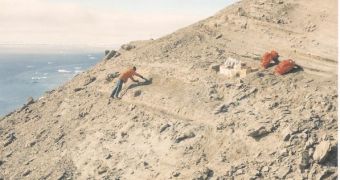Members of an expedition of the Antarctic Institute of Argentina, have discovered ancient turtle fossils, dating from 45 million years ago, in the La Meseta Formation on Antarctica's Seymour Island.
There are many things unknown about these fossils, like whether they belonged to a single turtle or not, and to what turtle species they belong, but one thing is clear – the fossils belong to the Eocene Epoch.
These two fragments of turtle shell are not from any species that was known to live in this area, at that time.
This discovery is quite amazing as it can give scientists clues about the temperatures and the environment of Antarctica during this era.
Researcher Marcelo S. de la Fuente of the Natural History Museum in San Rafael, Argentina, said that “the new fossils show the diversity of turtles was greater in Antarctica in the Eocene than previously thought.”
De la Fuente told LiveScience that “high diversity is not common in cold waters,” but more in tropical areas or even in moderate warm waters.
Apparently, during the Eocene, the Earth was a bit different than it is today, and at the beginning of this era, Antarctica and Australia were connected.
Also Antarctica was much warmer and it might even contained a rainforest at an early stage, before cooling over time.
The fact that these ancient turtle bones were found here, suggests that in this area there was a big turtle diversity, which only means that the Antarctic continent was still much warmer that some researchers have stated.
At that time, de la Fuente said, vertebrates – backboned animals like turtles, were quite common in the ancient South Pole.
And as teams have already discovered many shark bones, bony fish, whale and penguin fossils, his affirmation stands.
The new discovery is published in detail in the October 2010 issue of the journal Antarctic Science.

 14 DAY TRIAL //
14 DAY TRIAL //